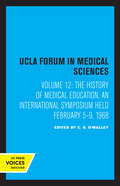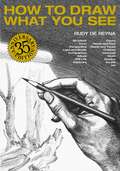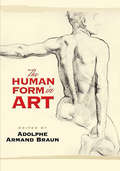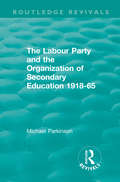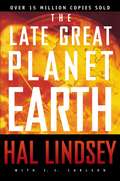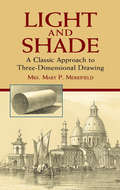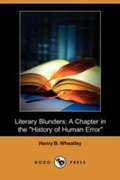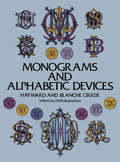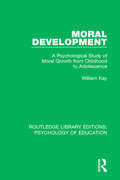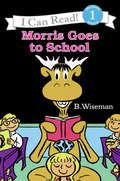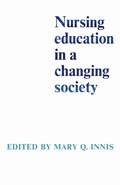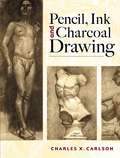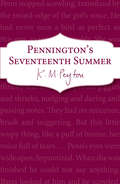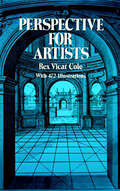- Table View
- List View
The History of Medical Education: An International Symposium Held February 5–9, 1968 (UCLA Forum in Medical Sciences #12)
by C. D. O’MalleyThis title is part of UC Press's Voices Revived program, which commemorates University of California Press’s mission to seek out and cultivate the brightest minds and give them voice, reach, and impact. Drawing on a backlist dating to 1893, Voices Revived makes high-quality, peer-reviewed scholarship accessible once again using print-on-demand technology. This title was originally published in 1970.
How to Draw What You See
by Rudy De ReynaWhen it was originally published in 1970, How to Draw What You See zoomed to the top of Watson-Guptill's best-seller list--and it has remained there ever since. "I believe that you must be able to draw things as you see them--realistically," wrote Rudy de Reyna in his introduction. Today, generations of artists have learned to draw what they see, to truly capture the world around them, using de Reyna's methods. How to Draw What You See shows artists how to recognize the basic shape of an object--cube, cylinder, cone, or sphere--and use that shape to draw the object, no matter how much detail it contains.From the Trade Paperback edition.
The Human Form in Art
by Adolphe Armand BraunAs individual as a snowflake, the human body is a marvel of form and function. This dramatic compilation of 166 studies—photographs, line drawings, and sculptures—serves as both an exhilarating exhibition and an important reference. Key topics include:AnatomyProportionMotionOther advice covers the selection of models, the human form in sculpture, and the role of art in the theater. Artists at every level of experience as well as art lovers will benefit from this classic guide.
The Individual, Marriage and the Family
by Lloyd SaxtonA truly inter-disciplinary approach, this text incorporates biological, psychological and sociological perspectives to the study of the family.
The Labour Party and the Organization of Secondary Education 1918-65 (Routledge Revivals)
by Michael ParkinsonOriginally published in 1970, Michael Parkinson examines the Labour Party’s attitude towards secondary education in general and comprehensive schooling in particular and shows the effect of the party’s philosophy on the question of education and its social importance. The Labour Party is seen both as a policy-maker with the power to implement policies and as a pressure group with power only to influence. The case study provides valuable background reading to the controversies over comprehensive education at the time.
The Late Great Planet Earth
by Carole C. Carlson Hal LindseyThe impact of The Late Great Planet Earth cannot be overstated. The New York Times called it the "no. 1 non-fiction bestseller of the decade." For Christians and non-Christians of the 1970s, Hal Lindsey's blockbuster served as a wake-up call on events soon to come and events already unfolding -- all leading up to the greatest event of all: the return of Jesus Christ. The years since have confirmed Lindsey's insights into what biblical prophecy says about the times we live in. Whether you're a church-going believer or someone who wouldn't darken the door of a Christian institution, the Bible has much to tell you about the imminent future of this planet. In the midst of an out-of-control generation, it reveals a grand design that's unfolding exactly according to plan. The rebirth of Israel. The threat of war in the Middle East. An increase in natural catastrophes. The revival of Satanism and witchcraft. These and other signs, foreseen by prophets from Moses to Jesus, portend the coming of an antichrist . . . of a war which will bring humanity to the brink of destruction . . . and of incredible deliverance for a desperate, dying planet.
The Late Great Planet Earth
by Hal Lindsey C. C. CarlsonA look at what biblical prophecy tells us about our times, the future, and the return of Jesus Christ.
Light and Shade: A Classic Approach to Three-Dimensional Drawing
by Mary Merrifield"Form," writes the author, "is developed by means of light and shade; without these every object would appear flat." Originally published in the mid-nineteenth century, this classic approach to three-dimensional drawing was the first book to provide art students with instructions for correctly illustrating perspective outlines of various objects. An art historian noted for her authoritative reference works, Merrifield clearly demonstrates the principles of light and shade by revealing the effects of common daylight, sunshine, and candle or artificial light on geometrical solids. Her simple explanations are accompanied by illustrations of cubes, prisms, pyramids, cylinders, spheres, ovals, and cones.As useful and practical today as it was when first published well over a century ago, Light and Shade provides beginning and advanced art students with valuable insights into effective drawing and sketching.
Literary Blunders: A Chapter in the "History of Human Error"
by Henry B. WheatleyLinguist Wheatley discusses typographical errors, "Irish bulls," deliberate and accidental misquotations, poor translations from other languages into English and vice versa, and errors of fact in student papers and examinations.
Marxism and Problems of Linguistics
by Joseph StalinThis book focused against dogmatism in Marxist thought on language, but it also presents irrefutable arguments against idealist, naturalist and formalist thinking on language as well as clarifying the Marxist approach and method on basic questions of linguistics.
Monograms and Alphabetic Devices
by Hayward Cirker Blanche CirkerThis book contains the entire contents of four fine volumes of monogram and allied devices published between 1830 and 1881. Over 2,500 monogrammatic and alphabetic designs are displayed in plates from "Dictionnaire du Chiffre-monogramme," etc., by Charles Demengeot (1881); "Monograms and Ciphers," by H. Renoir (1870-74); "Knight's New Book of Seven Hundred & Fifty Eight Plain, Ornamented & Reversed Cyphers" (1830); and "Monograms in Three and Four Letters," by J. Gordon Smith (n.d.).There are monograms in every two-letter combination and extensive selections of three and four letters; name devices ("Alice," "Theodore," etc.), crowns, crests, coats of arms and helmets. There are heavy, intricately entwined monograms that appear as though engraved on metal; lighter, thick-and-thin script styles; fanciful and formal designs; monograms in circles, ovals, square shapes, and free outline; and an immense variety of letter styles, including many designed for the particular device.A notable feature of this volume is the Index of Monograms and Ciphers, listing alphabetically every letter combination shown and the page or pages on which each appears ("S W", for example, is drawn in three different styles; "A L" in five; but "F N H W" in only one); and an Index of Names and Devices. Both features add greatly to the usefulness of the book. Importantly, every device shown may be reproduced by the purchaser free of charge.Artists, designers, engravers, and craftspeople will find this book a prolific source of inspiration and unusual styles; typographers, calligraphers, draftspeople , and students will use it as an aid in creating their own letter designs; while those in the printing, publishing, advertising, and allied fields will call upon it whenever a distinctive monogram or decoration is needed.
Moral Development: A Psychological Study of Moral Growth from Childhood to Adolescence (Routledge Library Editions: Psychology of Education)
by William KayAlthough the work of Piaget dealt with the intellectual development of children, and that of Goldman with a child’s religious thought, there had hitherto been no comparable book on child morality to complete the developmental picture of the time. Originally published in 1968 William Kay’s book was designed to fill this gap, for he offers a complete description of the moral growth of children from infancy to adolescence. Dr Kay was writing specifically for students and practising teachers and carefully avoids specialist jargon where ordinary terms suffice. He concludes that the findings of research into attitude formation and change could provide teachers with those techniques to help their pupils become morally mature members of society. His book contains a valuable analysis of the development of ideas concerning moral growth, and is a bold contribution to the problems of moral education.
Morris Goes to School (I Can Read Level 1)
by B. WisemanMorris the Moose can’t read or count, so he decides to go to school. After a day of ABCs and 123s, Morris is thrilled with all that he has learned.This classic silly Level One I Can Read is perfect for shared reading with a child. For fans of Danny and the Dinosaur, Sammy the Seal, or anyone who loves to read silly stories about animals.
Nursing Education in a Changing Society
by Mary InnisRapid social change and the advances made in the field of health care have greatly changed the role and function of the nurse in the last fifty years. Nursing is now almost a full-fledged profession. This book celebrates the fiftieth anniversary of the School of Nursing of the University of Toronto. The field it covers is wide and varied – from care of the sick by the nuns of early Quebec to the development of pre-paid nursing plans, from concepts of "beside nursing" to "delivery health services." There are long looks into the future of nursing education and health care which include descriptions of health science centres, diagnosis by computer, and treatment centres in outer space. The book sketches the history of this pioneer school of nursing, surveys nursing legislation, and examines the rise of the public-health nurse and the nursing assistant. Essays contributed by leading Canadian authorities show a wide range of opinion: one writer wants to see the scope of nursing education enlarged, another thinks it is too broad already. At a time when nursing education is becoming an increasingly controversial subject, this book will be of interest and value to all those in the health field.
Pencil, Ink and Charcoal Drawing: Four Volumes Bound as One
by Charles X. CarlsonThis original compilation gathers together four of Charles X. Carlson's finest art instruction books and presents them in one comprehensive volume. A well-known artist, author, and teacher, Carlson offers clear, uncomplicated methods of drawing for aspiring artists at every level. Chock-full of step-by-step illustrations, this compendium expertly covers the fundamentals of drawing figures, portraits, still-lifes, and landscapes for a wide variety of mediums. An all-in-one guide for art students, it includes: Simplified Ink, Pen and Brush Drawing opens the door to a number of drawing techniques, including spattering, stippling, cross-hatching, accented strokes, and the use of chalk and crayon. Simplified Drawing teaches artists the ABCs of free-hand drawing and features the basic principles of an object's construction using the easy "block method." The Simplified Essentials of Charcoal Drawing discusses charcoal materials and how to use them, and includes various techniques of charcoal drawing with application to cast, life, and outdoor sketching. Simplified Pencil Drawing presents the various methods of pencil drawing, step by step, while building students' knowledge of the subject and encouraging them to develop their own individual pencil techniques.
Pennington's Last Term (Pennington #1)
by K. M. Peyton"Idle and destructive in class," his report card said. "Character and obedience unsatisfactory in the extreme." Under Music his teacher had written, "May God forgive this boy for abusing so unusual a talent." Aimless, insubordinate, a 196-pound hulk of a boy, Patrick Pennington had been committed (his own words) to a fifth year at Beehive secondary school. Now his last term still stretched before him, a prospect of unrelieved boredom and torment. "Soggy" Marsh, the sadistic form master, had given him two days to have his shoulder-length hair cut. The new police constable was out to get Penn into reform school. Even gentle Crocker, his piano teacher, seemed to be trying to break him. But out of Penn's bitterness and rage, there grows a sudden deep sense of himself as one day, in a piece of music, he finds an elation, a fierce and irrepressible pleasure. Scornfully rebelling against the arbitrariness of authority, against his parents, the law, and his teachers, Penn unexpectedly discovers in his own abilities a key to a meaningful life. Pennington's revolt against the hypocrisy of the adult world in which he must live will speak directly to all young readers. K. M. Peyton, the winner of the 1969 Carnegie Medal, has written a moving, powerful, and at the same time outrageously funny story about a very believable and very contemporary young man.
Pennington's Seventeenth Summer: Book 1 (Pennington #1)
by K M PeytonPatrick Pennington is out of control, and seems to be heading for disaster. But when he meets Sylvia, he feels like his world has been turned upside down. Penn's seventeenth summer could be the most memorable of his life . . .
Perspective for Artists (Dover Art Instruction Ser.)
by Rex Vicat ColeRex Vicat Cole makes learning about perspective an enjoyable and fascinating pursuit in this clearly written and profusely illustrated book. Over 390 diagrams illustrate every aspect of the text, and more than 80 illustrations reproduce drawings and paintings — by old masters and by the author — that indicate how perspective is utilized in practice. The book is so well illustrated that many perspective problems can be answered without reference to the text at all. The text itself clarifies the theory of perspective and offers numerous practice exercises. Among the topics covered are the principle of perspective in theory, the rules of perspective and their application, depths, the use of plans in sketching foreshortened surfaces, inclined planes, the circle, arches, how to draw curves by straight lines, perspective of the sky and sea, perspective of shadows, and more. Two additional sections cover perspective in the history of art and mechanical perspective.A noted landscape painter and art instructor, Mr. Cole combines common sense with an understanding of Nature's laws to make perspective a subject that every artist can approach with confidence. Art students will also find this book extremely valuable.
